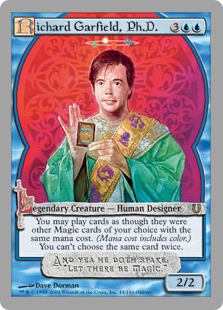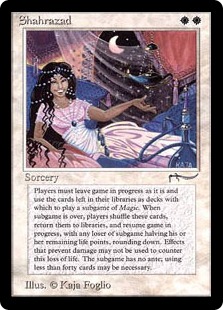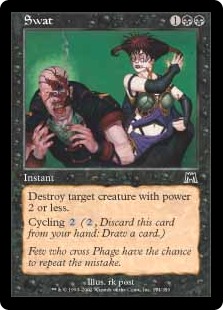
Cranial Insertion
Mathemagics!
By Eli Shiffrin, Brian Paskoff, and Carsten Haese
Mathemagics!
By Eli Shiffrin, Brian Paskoff, and Carsten Haese
[This article is available in Italian here.]
[This article is available in Spanish here.]
Ever since we answer that Precursor Golem and Rite of Replication question two weeks ago, we've been getting a lot of comments about it. I believe it's actually our most talked about question ever that isn't related to Warp World (though Precursor Golem combos nicely with Warp World), and everyone I know who reads us has been laughing about the millions of Golems. It's gotten to us so much that we got a little ahead of ourselves, got a truckload of Golem tokens from Wizards, and started an EDH game with Precursor Golem, Hive Mind, and Rite of Replication in all our decks. There's no such thing as infinite in Magic, but damnit, we're gonna try.
While we consult some higher mathematicians to try to figure this out (and figure out what to do with millions of Golem tokens), send in your questions to [email]cranial.insertion@gmail.com[/email].

Anyone know any mathematicians?
Anyone? Anyone? No?
Anyone? Anyone? No?
Q: Suppose I have just the one Precursor Golem and its two tokens out, and my opponent casts Flesh Allergy on one of them. I just lose 6 life, right?
A: You'll lose a bit more than that. The important thing to remember is that not all the copies of Flesh Allergy resolve all at once, they resolve one at a time. So the first one resolves, and you lose 2 life (provided no other creatures died that turn except the creature used to pay the cost for Flesh Allergy and the first Golem in line). Then the second resolves, and you lose 3 life (sacrificed creature + first Golem + second Golem) and so on until all the Golems are dead.
Q: Does Samurai of the Pale Curtain exile itself if it's destroyed?
A: Yes! Samurai of the Pale Curtain is on the battlefield while the game is determining which replacement effects to apply to a permanent being put into the graveyard, so it'll wind up exiled.
Q: My last round opponent happens to be a friend of mine, and we're playing for top 8. We're in extra turns and going to draw, which would mean neither of us gets into the top 8. Can we roll a die to see who gets in?
A: Definitely not! That's Improperly Determining a Winner, and will get both of you disqualified. One of you can decide to scoop to the other out of the goodness and kindness of their heart, but any random method to determine and neither one of you will be going to the finals.
Q: If I have a Sower of Temptation in play, and my opponent casts a Quicksilver Gargantuan copying my Sower, can he take one of my creatures?
A: He can. Quicksilver Gargantuan enters the battlefield as a Sower of Temptation, because the choice to copy a creature is made as it enters the battlefield. Therefore, any "enters the battlefield" triggered abilities will trigger, and he'll get to gain control of a creature.
Q: So same deal with the Quicksilver Gargantuan copying a Sower of Temptation. If my opponent cracks a Ratchet Bomb with four counters on it - does Quicksilver Gargantuan die?
A: It will. Copy effects copy everything about the object they copy that's printed on that object, including converted mana cost. Of course, Quicksilver Gargantuan has an exception in its power and toughness, which is set by its own copy effect, but its converted mana cost is still the same as the Sower it's copying.

It's like a game inside
a game inside a Taco Bell
inside a KFC inside a mall
inside your dream!
a game inside a Taco Bell
inside a KFC inside a mall
inside your dream!
A: Well it's hard for us to ignore the fact that Shahrazad is banned in everything, but I suppose this could happen in a one-on-one EDH tournament where the person playing Shahrazad was a toooootal jerk for playing that card in EDH. When the five turns end, so does the sub-game. You'll go back to the main game, and each player who lost will lose half their life. If state-based actions don't cause anyone to lose at this point, the real game will be a draw too! Unless you're in a sub-sub-game, then you'll just ride the kick up the levels of game until you get to the real one.
Q: My Moriok Replica is equipped with a Sylvok Lifestaff. I'm at one. Can I pop it without losing the game?
A: The first step to activating an ability is to place it on the stack. Later on during activating that ability you'll pay the costs to activate it, which includes sacrificing Moriok Replica. This triggers Sylvok Lifestaff's ability, which goes on the stack on top of Moriok Replia's, so it'll resolve first. You'll gain 3 life, then lose 2 life and draw two cards.
Note that if Moriok Replica had "pay 2 life" in the cost to activate its ability, you couldn't use it at all, since you can't pay more life than you have, and if you had two life, state-based actions would kill you before anything else resolved.
Q: If you cast Emrakul, the Aeons Torn in the last of the five additional turns after time expired do you actually get an "extra" turn or game is over before you get the turn?
A: Five turns means five turns total, including any extra turns you're given. Casting Emrakul in turns one to four in extra turns will eat up a turn that your opponent would have, but casting it in turn five won't help you. This is one of the rare times (maybe the only one) when Emrakul's pseudo-super-haste doesn't work in your favor.
Q: Assume my opponent controls two Palace Guards and a Jace, the Mind Sculptor. I attack with two Molder Beasts, one attacking Jace and the other attacking my opponent. He blocks both of my guys with both Palace Guards. Is it possible for me to assign damage to Jace and the player or can I only choose to deal damage to one of them?
A: Assigning combat damage is kinda like assigning attackers: you say "I want combat damage to end up assigned like this," and then you check if it's legal. So you can say "I want Beast #1 to assign 2 to each Guard and 1 to you" and "I want Beast #2 to assign 2 to each Guard and 1 to Jace." Then the game looks: Assuming the Molder Beasts are still just 5/3, each Guard is being assigned 4 damage which is lethal, 1 damage is being assigned to the defending player from a creature with trample, and 1 damage is being assigned to an attacked planeswalker from a creature with trample. So it's all legal!
Q: My opponent thinks I'm about to cast a Demon of Death's Gate by sacrificing three Bloodghasts. Since he knows what I'm going to do, he whips out a Lightning Bolt during my main phase to kill a Bloodghast so I can't cast Demon of Death's Gate, saying I can't cast a creature spell without flash because his Bolt is on the stack. Is this legal?
A: It's not. Magic isn't a game of reflexes, it's about priority, and you have priority during your main phase. If you cast a spell or cause anything to be put onto the stack, then he can respond with the Bolt and kill your Bloodghast, but as long as the first thing you do is either play a land or cast your Demon, he can't respond by killing your creatures.
Q: Can I sacrifice the same Reassembling Skeleton three times to pay for the alternate cost of Demon of Death's Gate if I've got up to pay for bringing back the Skeleton twice?
A: Nope. You can make a Demon from the bones of three Skeletons, but they'll need to be three different ones. You won't get priority while casting the Demon to activate your Skeleton from the yard.
Q: I've already played a land for my turn and resolve a Genesis Wave for five, revealing four lands. Can I put them all onto the battlefield?
A: Sure! There's a one land per turn limit on how many lands you can play (circumvented by some cards like Oracle of Mul Daya or Fastbond) but there's no limit to how many lands you can put onto the battlefield in any given turn. Compare this to something like Brilliant Ultimatum or Mind's Desire, which tells you to "play" the cards - that one won't get you any more lands.
Q: My Chimeric Mass has a -1/-1 counter and four of its own charge counters on it. I want to proliferate it with Steady Progress, but of course I want to only put on a charge counter, not a -1/-1 counter. Can I do that?
A: Not only can you, you have to! When you proliferate, you don't add a counter of each type to a chosen permanent. Instead you choose one type of counter on that permanent or player and add another counter of that type. Your Chimeric Mass will only get bigger (or smaller, if you want for some reason).
Q: If my Ogre Geargrabber steals my opponent's Grafted Exoskeleton, what happens at the end of the turn when Grafted Exoskeleton becomes unattached? Does my Ogre get sacrificed?
A: This little interaction is actually semi-covered in the FAQ, though not directly referencing the cards involved, which has caused a lot of players to overlook it. Generally we don't post questions here that are covered in the FAQ because we assume everyone reads it, but this one's been asked enough! The Ogre won't get sacrificed. When Grafted Exoskeleton's triggered ability resolves, it's not controlled by Ogre Geargrabber's controller, and you can't sacrifice something you don't control! (Otherwise Culling Dais would be a bit broken.)
Q: I control Goblin Sharpshooter and someone plays Wrath of God with five other creatures in play. Can I activate Sharpshooter more than once? How about if I cast Plague Wind when I have a Sharpshooter? Do I get five activations off of Sharpshooter then?
A: Wrath of God destroys everything at once, so unless your Goblin Sharpshooter is indestructible, it's a moot point that Goblin Sharpshooter triggers for each creature that's put into the graveyard from the battlefield. Plague Wind makes your Sharpshooter's cannons start revving though. His ability reads "Whenever a creature is put into a graveyard..." so he'll trigger for each creature that dies. You can activate him, let the top triggered ability on the stack resolve, then activate him again, let another trigger resolve, and so on until all the triggers are gone, pinging your opponent for lots of damage.

What did the five fingers
say to the Goyf?
say to the Goyf?
A: I've seen a lot of Niv-Mizzet, the Firemind EDH players confused about how this card works with spells cast in response to Mindmoil's trigger, but it's really not as confusing as it looks! Each time you cast a spell, Mindmoil's triggered ability goes on top of that spell. It resolves, you draw a new hand, then your spell resolves, then Mindmoil's trigger resolves, then your spell resolves. It's a lot of tossing hands away and card drawing, but nothing too crazy (unless you have a Niv-Mizzet and Sakashima the Impostor copying him).
Q: Can Swat kill a 2/3 Tarmogoyf if there's no instants already in the graveyard?
A: Sure! Swat checks to make sure its target is legal twice, when it's cast and when it starts to resolve. Swat doesn't end up in the yard until it's finished resolving, so there's no time where Tarmogoyf sees Swat in the graveyard for it to be a 3/4 until both Swat and Tarmogoyf are in the yard. This is different from Lightning Bolting and a 2/3 Goyf with no instants in the yard. In that case, Bolt resolves, the Goyf has 3 damage on it, but now there's an instant in the yard and Tarmogoyf is a 3/4 with 3 damage on it when state-based actions are checked.
Q: If I cast Cerebral Eruption and my opponent controls a planeswalker, do I choose whether I want to redirect the damage to the planeswalker before or after the card is revealed?
A: When redirecting damage to a planeswalker your opponent controls from a non-combat source, you do it as the damage is dealt, not as the spell or ability that's going to deal damage is resolving. So you can wait and see whether it's smarter for you to nuke your opponent's planeswalker or just have them take the hit once you see how much damage you're dealing.
Q: For a long time my friends and I used to compare the converted mana cost of the bottom cards of our libraries to see who goes first, but when we went to FNM we were told that's not allowed and we need to choose a random method like rolling a die. Isn't the bottom card of our decks random?
A: It's random (hopefully, if you've shuffled well enough) but it's only random in regards to your deck. Your opponent's mana curve might be way less than yours, or vice-versa, giving you a much greater chance to go first. Rolling dice or flipping a coin is a quick way to see who goes first... but feel free to do whatever you want at your kitchen table.
Q: Do I need a certified judge to run a sanctioned FNM?
A: No, but it's certainly nice to have one, as my players can attest! You don't need a certified judge to sanction a small tournament like an FNM, or SAM (Saturday Afternoon Magic) or any three letter acronym tournament short of a PTQ or GPT. You will need to appoint someone as your judge, but if you're running the event, the usually might as well be yourself. All the rules questions must go to whoever you appoint as your judge. Getting a certified judge helps, but it's not necessary.
Okay, so we just gave up and made a giant Golem out of Golem tokens. It's blocking the exit, so uh... does anyone have a Lightning Bolt, or an Unsummon... hell, we'd even take an Acceptable Losses at this point. Anyway, tune in next week for Carsten!
Comments